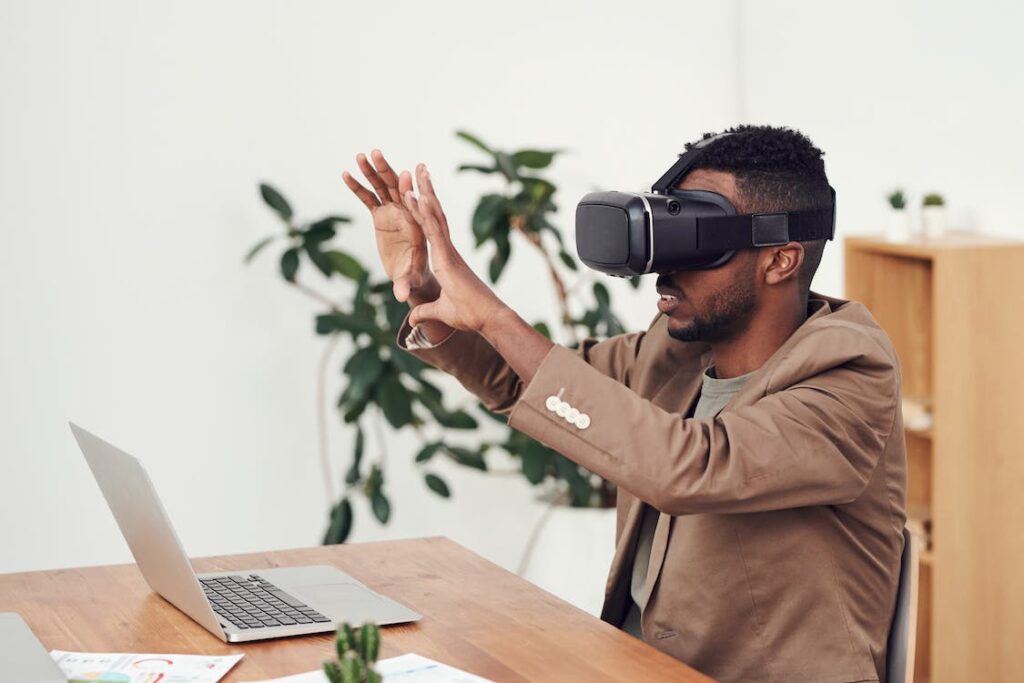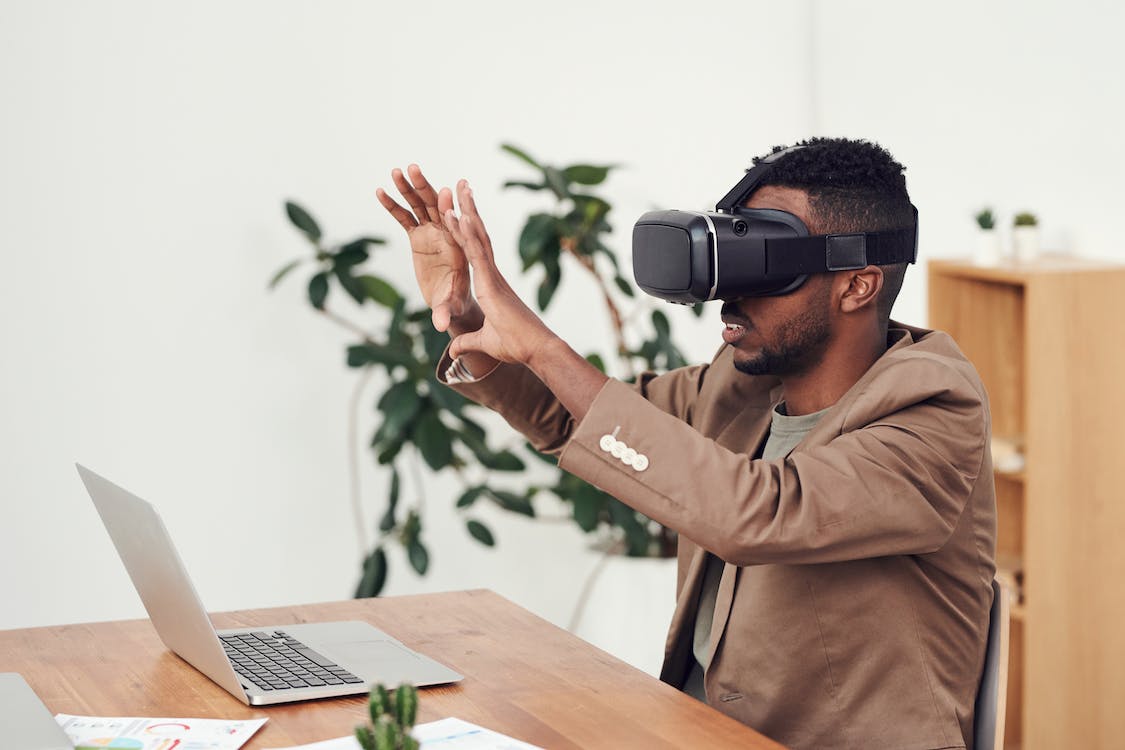The construction industry, traditionally viewed as slow to adapt to new technologies, is undergoing a transformative shift driven by the rapid progress in digital innovation. Among these advancements, Augmented Reality (AR) and Virtual Reality (VR) technologies are now playing a pivotal role, ushering in a new era of planning and designing. These powerful technologies are revolutionising the industry by enhancing communication, improving design processes, increasing safety, and reducing construction costs.

Understanding AR and VR
Before diving into their impact, it’s essential to understand what AR and VR represent. Augmented Reality (AR) superimposes virtual images and data onto real-world environments, often through the lens of a smartphone or special glasses. Virtual Reality (VR), on the other hand, immerses users in a fully artificial, three-dimensional environment that can be interacted with in a seemingly real way through the use of special VR headsets.
AR/VR in Design and Planning
AR and VR technologies are significantly impacting the planning and designing stages in construction. Architects and engineers can use VR to create detailed 3D models of their projects, allowing them to visualise the final product before construction even begins. It provides stakeholders an immersive walk-through experience, enabling them to understand the spatial aspects and aesthetics of the design more intuitively.
AR takes this a step further by integrating these 3D models with real-world environments. For example, using AR, a construction professional can overlay a digital blueprint onto a physical site, facilitating a real-time comparison between the design and the actual site conditions. This powerful visual tool assists in identifying any discrepancies between the planned design and the site, enabling the team to make necessary adjustments before construction commences.
Enhanced Communication and Collaboration
In an industry where effective communication can make or break a project, AR/VR provides an efficient platform to express complex ideas. By immersing team members in a shared, interactive environment, VR facilitates a better understanding of the project. This collaborative approach aids in spotting potential issues early in the design phase, which significantly reduces the time spent on revisions and costly rework.
Training and Safety
Safety training is another critical area in the construction industry benefiting from AR/VR technologies. Traditional safety training methods often struggle to replicate the potential dangers workers could face on the construction site. However, VR can simulate hazardous situations realistically and safely, providing an immersive and interactive training environment. Such practical training ensures that the workers are better prepared to handle real-life challenges on the site.
AR can also contribute to safety by overlaying safety information and guidelines on the workers’ field of view during the actual work. For example, it can display the load capacity of a crane or highlight potentially hazardous areas on the site.
Reduced Costs and Increased Efficiency
By enabling early detection of design errors, improving coordination among teams, and reducing rework, AR/VR can significantly reduce the overall cost of a construction project. Moreover, the technology can assist in scheduling and sequencing the construction phases, thereby improving efficiency.
As AR/VR technologies continue to evolve, their accuracy and functionality are expected to increase. Soon, it might be possible to use these technologies for accurate on-site measurements or to automatically monitor the quality of work, further driving the industry’s efficiency and productivity.
From an architectural standpoint, AR and VR allow for more than just robust visualisations. Architects can use these tools to experiment with different materials, textures, and colours, providing the client with several iterations of design proposals. Furthermore, it allows them to test the interaction of the building with different environmental conditions such as sunlight, rain, and wind.

Moreover, VR can be a powerful tool for stakeholder engagement. It allows the clients to understand the design in-depth, immersing them in the architect’s vision for the project. By putting clients into a 3D, lifelike representation of the planned space, designers and architects can navigate them through the project, making necessary adjustments based on their feedback in real-time.
On the other hand, AR applications are bringing BIM (Building Information Modeling) to the field. Workers on the site can overlay BIM models on their physical surroundings, visualising the infrastructure components in relation to the actual site conditions. This can significantly enhance on-site coordination, reduce rework, and prevent potential conflicts between different building systems.
The integration of AR/VR technologies with AI and machine learning can further enhance these advantages. Predictive algorithms could feed into AR/VR environments, enabling the simulation of different project outcomes based on varying inputs. These predictive insights can guide decision-making, resulting in better project outcomes.
Furthermore, AR/VR could also revolutionise facility management in the post-construction phase. A 3D digital twin of the building, combined with AR, could enable the maintenance staff to visualise and understand the building systems more effectively. This could improve the efficiency of maintenance and repair activities, extending the building’s life cycle.
As AR/VR technologies become more affordable and accessible, their adoption within the construction industry is set to increase. According to a report by MarketsandMarkets, the AR and VR market in construction is projected to grow from USD 1.4 billion in 2018 to approximately USD 4.7 billion by 2023. This growth signifies the sector’s recognition of the transformative potential of these technologies.
Education is a critical aspect of the construction industry. The ability to teach, train, and prepare workers for real-world construction scenarios is paramount in ensuring that projects are executed safely and efficiently. AR and VR technologies are increasingly being leveraged to provide immersive, practical training experiences. For instance, an apprentice can learn to operate complex machinery in a safe, virtual environment before moving onto the actual equipment.
Moreover, these technologies can replicate hazardous construction situations, allowing workers to understand the risks and appropriate safety measures without placing them in actual danger. Virtual environments can simulate everything from high-rise construction scenarios to confined spaces, enabling workers to gain experience and confidence in dealing with such situations. This form of ‘experience-based’ training could significantly reduce the risk of on-site accidents and improve overall safety standards in the industry.
Another future-forward application of AR/VR is in the realm of remote collaboration. As the world becomes increasingly interconnected, construction teams can be spread across different geographies. AR/VR can bridge this physical gap by enabling real-time collaboration in a shared virtual space. This can enhance coordination, minimise misunderstandings, and facilitate more informed decision-making, regardless of where the team members are located.
Lastly, it is important to note that AR and VR can significantly contribute to sustainability in construction. By creating virtual prototypes, construction companies can avoid unnecessary material waste that often results from traditional physical mock-ups. Furthermore, by improving the precision and accuracy of project planning and execution, these technologies can help reduce energy use and carbon emissions.
Despite these advancements, it’s crucial to address the challenges that come with the integration of AR and VR in construction. High costs of equipment, the need for robust technical support, potential cybersecurity threats, and a steep learning curve for employees are some of the potential obstacles. However, as technology continues to evolve, these challenges are expected to diminish.
Augmented and virtual reality technologies are more than just buzzwords in the construction industry – they’re the catalysts for a new era of planning and designing. As we move forward, it is crucial for industry leaders, technologists, and policymakers to work in unison to harness these digital tools fully, paving the way for a more innovative, efficient, and sustainable construction landscape.
As we step into the new era of construction, tools like Wunderbuild are pivotal in transforming the traditional construction processes. Wunderbuild offers smart project management and collaboration features, enhancing productivity, and facilitating smooth workflow in construction projects. Harness the power of modern construction software to stay ahead in this evolving industry. To learn more about what Wunderbuild can do for your projects, click here.




